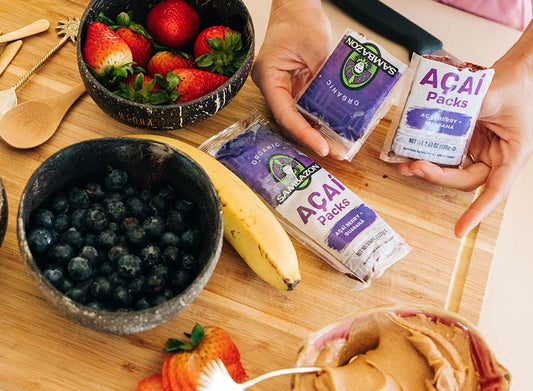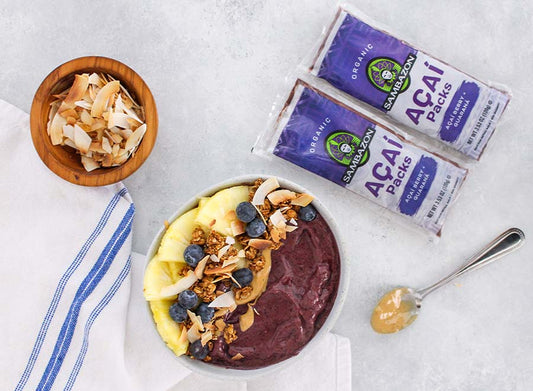You probably recognize most delicious ingredients at your local smoothie shop—bananas, oranges, pineapple, all the household favorites. However, you might squint at a few words up on that chalkboard. What exactly are Açaí and pitaya/dragon fruit?
Don’t worry—we’ve got your fruit basket covered.
Both pitaya and Açaí are tropical fruits with tasty flavor profiles and plenty of nutrients. However, there are a few key differences between the two (in this case, it isn’t apples to oranges). Keep reading to learn the complete breakdown between pitaya vs. Açaí, including:
- Plant origins
- Nutritional profile
- Flavor & uses
Plant & Origins
Even though pitaya and Açaí both grow in tropical climates, they come from completely different crops and cultures. Let’s compare the origins and plants of both fruits.
Pitaya Origins
Want to know a secret? Pitaya is just the native name for dragon fruit (or strawberry pear).
Common in Hispanic and Asian specialty stores, this oval-shaped fresh fruit is native to South America. However, you can find pitaya growing across many countries with warm and humid climates, including:
- Colombia
- Ecuador
- Guatemala
- Mexico
- Vietnam
- Thailand
- China
Known for their bright and leathery appearance, pitayas grow on climbing cacti vines—the Hylocerus undatus. Their outer skin is usually a vivid pink or yellow with noticeable “scales”, hence the name red dragon fruit. Inside their skin, you’ll find that it is slightly creamy and dotted with tiny black seeds.
Açaí Origins
Açaí berries love a tropical environment as much as pitayas. However, most Açaí fruit stems from one incredible location—the Amazon River basin.
Fertile and sprawling, the Amazon River basin runs across the top half of South America. Açaí berry trees thrive in this tropical environment (particularly in Brazil), alongside other humid countries like:
- Ecuador
- Colombia
- Chile
- Peru
Unlike pitaya, Açaí berries (or more accurately, drupes) are actually from palm trees. These dark, blue-purple stone fruits grow in clusters at the top of tall Açaí palms—up to 30 meters in height. Like large blueberries with pits, Açaí fruits have thin skin.
Pitaya Nutrition
Light yet nutritious, pitaya is a tasty addition to the base of your food pyramid. Toss raw or frozen pitaya onto your plate (or bowl) to reap a few of its possible perks:
- Macronutrients – A 100 gram serving of pitaya has 60 calories, nearly 86% coming from carbs.
- Vitamins & minerals – Pitaya’s superpower? A high dose of magnesium (about 10% per serving of the recommended daily intake). Pitaya flesh also offers a small amount of iron and vitamin B2, as well as antioxidants like flavonoids and hydroxycinnamates.
Açaí Nutrition
Açaí is known as a “superfood” for its incredible nutrient density. When you eat this unique Açaí berry, you may absorb macronutrients like carbohydrates and healthy fats. Unlike most fruits, Açaí berries contain about 65% fats and 35% carbohydrates. And if you’re wondering if Açaí is keto, be sure to check out our latest blog!
And if you’re curious about what an Açaí bowl is made of, check out our latest blog!
Flavor & Uses
Perhaps the most important question of all—what do these two tropical fruit options taste like?
Flavor might be the greatest difference between pitaya and Açaí. Pitaya has a lightly sweet taste reminiscent of watermelon. Açaí is usually described as earthy, a cross between blackberries and unsweetened cocoa. In the end, the choice comes down to your personal preference!
Another factor to remember? Preparation. Red dragon fruit flesh is typically served raw and cut into cubes (perfect for a quick snack) and you can now find Açaí and dragon fruit in products like:
- Dragon fruit juice
- Frozen fruit pulp
- Powder
- Extract
- Sorbet
- Frozen fruit cubes
SAMBAZON—Your Sustainable Açaí Source
At the end of the day, both of these tropical fruit options are pretty fantastic, especially when you learn how to store smoothies so you can cut down on the time you spend preparing meals for the week! But when it comes to nutritional powers and versatility, it’s tough to beat Açaí berries—and SAMBAZON delivers the best of this nutrient-dense superfood.
From frozen Açaí bowls to frozen fruit sorbet, SAMBAZON products are both delicious and responsible. We employ EcoCert Fair Trade standards in our Brazil plants, making your taste of the Amazon a responsible bite for every smoothie bowl you eat. Explore our products and community activism today, and join our movement towards a more giving and nutritious future.
Sources:
Britannica. Açaí. https://www.britannica.com/plant/Açaí
CABI. Hylocereus undatus (dragon fruit). https://www.cabi.org/isc/datasheet/27317
Healthline. 5 Impressive Health Benefits of Açaí Berries. https://www.healthline.com/nutrition/benefits-of-Açaí-berries
Healthline. Dragon Fruit: Nutrition, Benefits, and How to Eat It. https://www.healthline.com/nutrition/dragon-fruit
Natural Balance Foods. HOW DO WE KNOW LEVELS OF ANTIOXIDANTS IN FOODS? THE ORAC SYSTEM. https://www.naturalbalancefoods.co.uk/community/healthy-living/the-orac-system/
NCBI. White Pitaya (Hylocereus undatus) Juice Attenuates Insulin Resistance and Hepatic Steatosis in Diet-Induced Obese Mice. https://pubmed.ncbi.nlm.nih.gov/26914024/







Comments
(0 Comments)Please note, comments need to be approved before they are published.